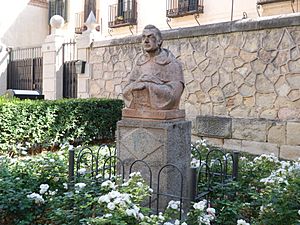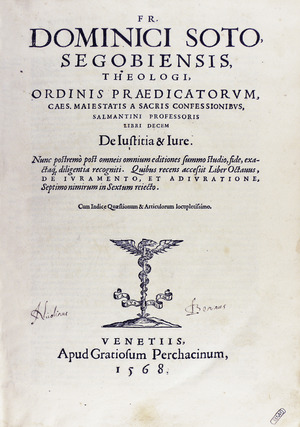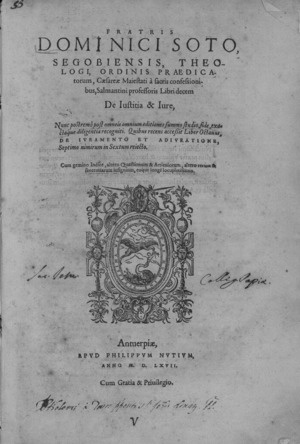Domingo de Soto facts for kids

Domingo de Soto (1494 – November 15, 1560) was a Spanish Dominican priest and scholar. He was born in Segovia, Spain, and passed away in Salamanca, Spain, when he was 66 years old. He is known for helping to create international law and for being a key figure in the School of Salamanca. This was a group of Spanish thinkers who followed the ideas of Thomas Aquinas.
Domingo de Soto also made important contributions to Mechanics, which is a part of physics. His ideas, shared in his book "Quaestiones" in 1551, were later used by Galileo in his own studies.
Biography
Domingo de Soto was born in Segovia. He studied at the University of Alcalá in Spain and in Paris, France. In 1520, he became a professor of philosophy at Alcalá.
In 1524, he decided to join the Dominican Order. He later returned to teaching in 1532, becoming a professor of theology at Salamanca University.
De Soto held important positions. He was the personal advisor to Holy Roman Emperor Charles V. He also represented the emperor at the Council of Trent, an important meeting of church leaders. He died in Salamanca.
Thought
Mechanics
In 1551, Domingo de Soto was the first person to clearly state an important idea in physics. He said that an object falling freely speeds up at a steady rate. This idea was very important for later studies on gravity by famous scientists like Galileo and Newton.
In the 20th century, a scholar named Pierre Duhem recognized de Soto's achievements. He saw de Soto's work as an early step towards modern mechanics.
Law
In 1556, Soto published a major book about law called De Justitia and Jure (Justice and the Law). This book is considered a very important text for understanding the general ideas of law, especially international law.
Like his teacher Francisco de Vitoria, Soto helped to develop new ideas about the Spanish conquests in the New World. He helped to build the concept of people's rights. This included the right to private property for the native people of the Americas. Soto also famously defended the rights of the poor. He spoke out against rules that limited how much help poor people could receive.
See also
 In Spanish: Domingo de Soto para niños
In Spanish: Domingo de Soto para niños



